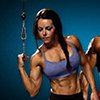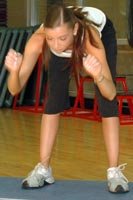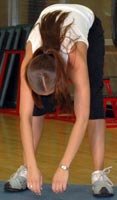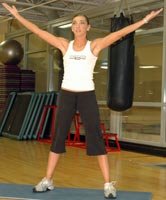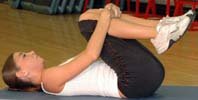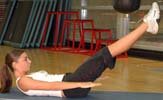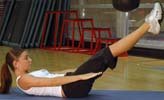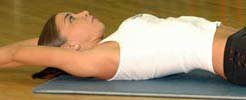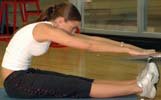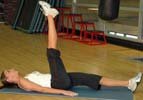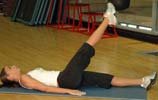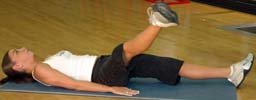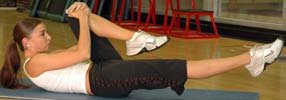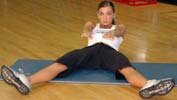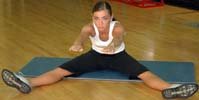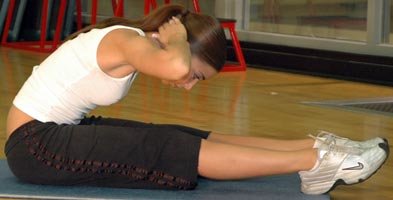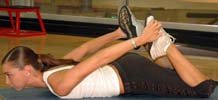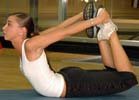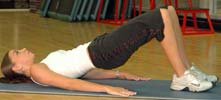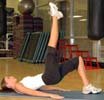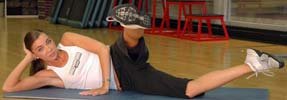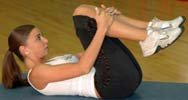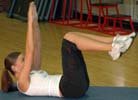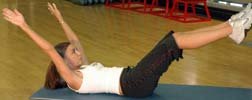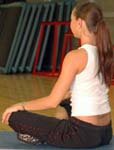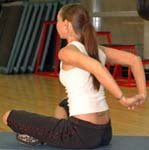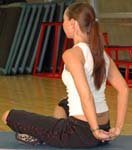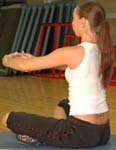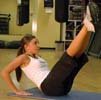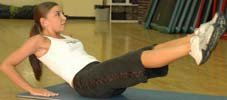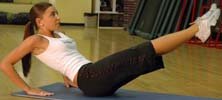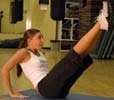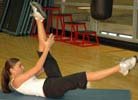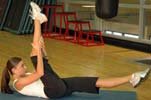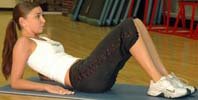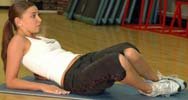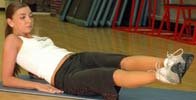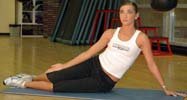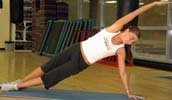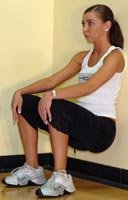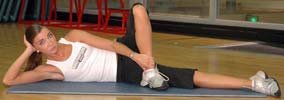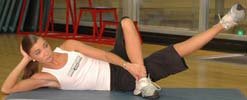
TOPIC: What Is The Best Pilates Workout?

The Question:
Anyone who has watched television knows about it. Pilates is one of the most popular workouts around today. It is used by a variety of people. It's a favorite among many celebrities.
What is the best Pilates workout? Be specific.
What are some of the benefits of Pilates?
Have you or someone you know used Pilates? How were the results?
Show off your knowledge to the world!
The Winners:
- RC26 View Profile
- Next_Gen_BB View Profile
-
New Prizes:
-
1st place - $75 in store credit.
2nd place - $50 in store credit.
To use your credit, e-mail Will @ will@bodybuilding.com for more info.

1st Place - RC26
View This Author's BodySpace Profile And Contact Them Here. 
Anyone who has watched television knows about it. Pilates is one of the most popular workouts around today. It is used by a variety of people. It's a favorite amongst many celebrities.

Introduction: What Is Pilates?
Are you tired of experiencing back pain or suffering from postural deficiencies? Is your life overflowing with stress? Did you know that Pilates can help you both physically and mentally?
Pilates is a physical fitness system developed by Joseph Pilates, which focuses on developing the body's core muscles. Furthermore, Pilates teaches body awareness, helps develop good posture, increases strength and flexibility, and creates a toned body.
In the past five years, more than 10.5 million people chose to use Pilates, and this includes top athletes, supermodels and Hollywood celebrities. So if you're looking for a safe way to transform the way your body looks and feels, then read on and learn about Pilates.

The Pilates Principles
Just like all training methods, Pilates consist of several principles and guidelines that teach trainees the correct way to exercise.
 Mind Over Matter:
Mind Over Matter:
The Pilates method mainly revolves around this principle, which advises the trainee to pay close attention to each movement. Doing this allows maximum use of body and strength, while minimizing weaknesses.
 Breathing:
Breathing:
Proper breathing is a vital component in each Pilates exercise, as it delivers fresh oxygen to the entire body. Breathing should be done in a concentrated and controlled manner.
 Centering:
Centering:
Pilates refers to the body's core as a powerhouse, and this includes the abdomen, lower back, hips and buttocks. Each exercise begins from the powerhouse to coordinate all movements, and strengthen the body's core.
 Concentration:
Concentration:
The ability to concentrate on the entire body's movements tends to be a difficult task for beginners, but with practice it can be achieved.
 Control:
Control:
Once concentration is accomplished, absolute muscle control needs to be taught. All movements require focus on finger, head and toe positioning, the back's arching or flattening degree, the rotation of the wrists, and the inner/outer rotation of the legs.
 Precision:
Precision:
Each Pilate's movement is detailed for a reason, and each exercise should be performed perfectly and precisely as indicated.
 Fluidity:
Fluidity:
All the Pilates exercises are based on the body's natural movements. It's recommended trainees execute the movements in slow, smooth and controlled motions to get the full benefits of this method.

Workout:
What Is The Best Pilates Workout? Be Specific.
 Warm-Up Exercises:
Warm-Up Exercises:
Stand with your feet shoulder-width apart, and reach your arms upward. Maintain a contraction in your abs and inhale.
As you exhale, allow your arms to fall forward and keep your knees gently bent. Your back should be arched. Relax your head and shoulders, and allow them to fall forward. Your movement should be a gentle stretch, with your arms eventually going down to your side. Then gently pull them behind you as far as you're comfortable.
From this curled position, inhale and slowly roll yourself back up to the upright position. Each time you repeat this movement, try to stretch a little further toward the sky, while pulling your spine and entire body upward.
Swinging Warm-Up:
Directions:
Use this exercise as a spine and back muscles warm-up. Move in a slow and controlled motion, and imagine you're swimming in water. Repeat this movement 20 times.
Stand at shoulder-width apart stance without locking your knees. Stretch your arms out in front of you, with your palms facing upward and take a deep breath in.
As you begin releasing your breath, stretch your arms up and to your sides, and contract your abs as you open your arms. Keep your back straight throughout the movement and avoid arching it, maintain a constant speed.
Chest Stretch:
Directions:
Repeat the movement 10 times, and try to spread your arms farther each time.
 Pilates Exercises:
Pilates Exercises:
Lie with your back flat on the floor, and your shoulders down. Point your feet and lengthen your body, leading the stretch with the top of your head.
Keep your back flat on the floor, raise both legs and raise your head off the floor. Make sure you keep your neck neutral and your chin tucked.
As you're keeping your arms extended, begin to lift and lower them about two inches from the floor, while inhaling on the lift and exhaling on the lower.
Do this for 5 up-and-down beats, and repeat 10 times until you have reached 100.
The Hundred:
Directions:
Lie on your back with your legs straight, your arms stretched above your head, and your shoulders down.
Keeping your back flat on the floor, begin to gradually lift your arms toward the ceiling as you inhale.
As you begin exhaling, slowly roll forward, while peeling your spine off the mat. Your head should remain straight, with your eyes focused forward. Keep your stomach tight, not crunched.
As you inhale again, stretch out over your legs. Then exhale and slowly roll back down to the floor.
Do not pause, but as you inhale, roll up again to begin the second repetition. Do 10 repetitions.
The Roll Up:
Directions:
Lie on your back with arms at your sides, and your palms facing down. Pull in your abs, extend your left leg toward the ceiling, and point your toe.
Rotate the leg clockwise. Inhale from 12 o'clock to 6 o'clock, and then exhale from 6 o'clock to 12 o'clock. Now rotate in the opposite direction.
Return the left leg to the floor and begin again, this time extending the right leg.
Repeat 5 times on each side.
One-Leg Circle:
Directions:
Lie on your back with arms at your sides, and your palms facing down.
Lift your head and shoulders off the floor, hold the right knee, extend the left leg out.
Keeping the head in alignment and elbows bent, gradually begin to switch sides, grasping the left knee and extending the right leg. Inhale for two changes, and exhale for two changes.
Do 10 changes, or 5 moves per side.
One-Leg Stretch:
Directions:
Sit with your legs extended and apart, with your hands on the floor between them.
Flex your feet and push your upper body forward. Then round your back, and pull in your abs in and up. Inhale as you round your back.
Exhale as you roll your back slowly, one vertebra at a time.
Repeat 10 times.
Spine Stretch:
Directions:
Lie flat on the floor with your fingers clasped behind your head, you legs stretched out, and your toes pointing away from you. Make sure that your back is in a neutral position, so you should be pulling in on your center.
Begin with your head, but pull with your abdominal muscles, not your neck, and peel your back off the floor, while exhaling. This movement should be executed in a slow and controlled manner. If you feel a strain in your back, allow your arms fall to your sides, and bend your knees. Pull in and up on your abs.
Stretch yourself as far onward as you can, and without stopping, lie back down slowly, to allow each of your vertebrae to touch the mat one by one. Be attentive of each disc and feel the imprint of each vertebra on the mat.
Neck Pull:
Directions:
Sit with your legs apart, about even with your hips and toes pointed upward. Lift your arms out to the sides so they're parallel to the ground, and wide enough so you can see them in your peripheral vision when you're looking straight ahead. Hold your head up high, as if you were trying to see over something in front of you.
As you begin to exhale, turn your body to the left. Make sure your arms are kept in line with your shoulders, and don't allow them cross in front of your body. Keep your hips facing to the front.
Continue to exhale and stretch your right arm to your left toe. You should now begin to feel some tension. Try imagining stretching over a large ball on your knee. You'll want to keep your head down as you stretch.
Inhale as you come back to the center of the position, then repeat on your right side.
Lie facedown on the mat, lift your legs, and hold onto your feet. Pull your abs in slightly off the floor, and stretch your legs while you push your ears forward.
Maintaining your strength in your center, and exhale as you lift your legs as high as possible.
Now begin to inhale as you allow your body to roll forward, and then exhale as you roll back onto your legs. Control your movement from your center.
The Saw:
Directions:
The Rocker:
Directions:
Lie on your back with your feet shoulder-width apart, and your knees bent. Reach your arms down along your side and pull your spine back toward your ears.
Inhale as you roll your hips upward, and slowly lift each of your vertebrae off the mat. Keep your abs contracted and only roll-up your spine as far as your shoulders, so that only your feet, shoulders, arms and head remain on the ground.
Now, as you exhale, unfold one leg and lift it upward, so it's perpendicular to the floor. Keep your hips steady at the same height, and do not allow them to drop. Use your center strength to hold yourself in place.
Inhale as you bring your leg down, and point your toe away from you. Keep your leg straight, and try to touch the floor as you slowly bring your leg back down. Then exhale and bring your leg back up.
Lower your leg again, and inhale as it touches the floor. Bring your knee back up next to the other leg. Slowly exhale as you roll your spine back down, allowing each vertebrae to fall onto the mat one by one.
Repeat this movement with each leg 10 times.
Shoulder Bridge:
Directions:
Lie on your side with your spine in a horizontal line, and stack you hips on top of each other. Place your hands on either side of your head, and use your lower arm to balance yourself on the floor. Then contract your abs and stretch your legs away from your center, lifting them slightly off the floor to maintain the horizontal line of your spine.
Exhale and move your top leg forward. Inhale as you bring it back. Inhale and repeat this motion on the other side.
Repeat this movement 10 times.
Sidekick:
Directions:
Lying flat on the mat, tighten your abs and keep your spine neutral. Bring your knees up toward your chest, and hold your lower legs parallel to the floor.
Place your hands on your knees, and inhale. Straighten your legs and keep arms parallel to each other at a 45-degree angle to the floor. Raise your head and shoulders off the mat so your chin is parallel to your arms and legs.
Keep your legs in the same position, and make a large continuous circle with your arms. Start by reaching behind your head with your arms fully straightened outward, then pull your arms around to your sides, making a complete circle as they come back to the 45-degree position parallel to your legs and then back to your knees.
Repeat this movement 10 times.
Double-Leg Stretch:
Directions:
Begin by sitting cross-legged, and straighten the spine as though resting against a wall.
Bend the elbows at a 90-degree angle to protect your shoulder in its socket, while take the arms back to connect the shoulder blades.
Then take the arms back down so the shoulder blades slide down your spine, and raise the bent arms above your head, just like a ballerina.
End the movement with your arms in front of you and get back to the starting position.
The Ballerina Arms:
Directions:
Start from a seated position with your abs contracted, and lift your legs to a balanced position with your hands on the floor behind you, pointing forward.
Lift your head, extend your spine, and stretch your legs away from you, while engaging the abs.
3. Inhale, point your toes, and circle the legs toward the left side ten times, then repeat in the opposite direction.
Lower the legs several inches down and circle ten more times on each side. Then lower the legs to about, 6 inches above the floor and repeat ten times on each side again.
Hip Twist:
Directions:
Lie flat on your back with your head and shoulders lifted off the floor, hands behind your head, and knees into your chest.
Extend your left leg so it's at a 45-degree angle from the floor, then pull in your abs while twisting your upper body to the right, so that your left elbow reaches toward your right knee and your right elbow is extended straight out from your ear. Hold for two counts, and then switch sides.
Do this four times, then repeat four more times holding for just one count, and end with four more times at an even faster speed.
Criss Cross:
Directions:
Waist Whittler:
Directions:
1. Lie on your left side, rest your head in your left hand, and steady yourself with your right hand planted firmly on the floor and in front of your chest. Keep your chest broad and open, and do not curl it down toward the floor.
2. Inhale and engage your abs, then raise both legs about 12 inches off the floor as you exhale. Hold for a count of four, then lower them to just above the floor. Inhale and raise again on the exhale.
3. Do this 8 times and repeat on the right side.
Sit on ground, lean back; place your forearms and hands flat on ground, elbows under your shoulders, knees bent, toes barely touching the ground and your legs and ankles together.
Keep your legs together and maintain a contraction in your abs, then inhale and let your knees drop down to the right, toward the ground.
Exhale and straighten your legs on a diagonal, then inhale and bend the knees (also on a diagonal).
Exhale, bring the legs back to the center, and immediately drop them to the left. Extend on a diagonal, and continue to alternate for 8-10 reps.
Cancan:
Directions:
Sit on your left hip, keep both knees bent, and your left leg tucked under your right, with right leg slightly extended a few inches to the right.
Place left hand on ground about 6 inches away from the body, and in line with the left shoulder, fingers turned outward, arm straight, and right arm resting on right knee, with the palm up.
Inhale and press down into the left hand, and lift your hips off the ground and directly up, flexing the torso to the left, so the left shoulder aligns over the left wrist.
Extend legs and straighten arms to a T-pose. Exhale, then lower to the starting position and bend the knees. Repeat 3-5 times on each side.
Mermaid Side Bend:
Directions:
 The Best Pilates Workout:
The Best Pilates Workout:
- Monday - Pilates
- Tuesday - Rest Day
- Wednesday - Pilates
- Thursday - Rest Day
- Friday - Pilates
- Saturday - Rest Day
- Sunday - Rest Day
- Warm-up - Swinging Warm-Up Stretch
- The Hundred - 5 up and down beats, repeat for 10 times until you reach 100
- Roll Up - 10 reps
- One-Leg Circle - repeat movement 5 times on each side
- One-Leg Stretch - 5 moves per side
- Spine Stretch - repeat movement 10 times
- Warm-up - Chest Stretch
- Shoulder Bridge - repeat movement with each leg 10 times
- Waist Whittler - repeat movement 8 times on each side
- Hip Twist - repeat movement 10 times
- One-Leg Stretch - repeat movement 5 times on each side
- Cancan - 8-10 reps
- Warm-up - Swinging Warm-Up Stretch
- Neck Pull - repeat movement 10 times
- The Saw - repeat exercise 10 times on each side
- The Rocker - repeat movement 10 times
- Sidekick - repeat movement 10 times
- Double Leg Stretch - repeat movement 10 times
The Split
Monday - Pilates:
Tuesday - Rest Day.
Wednesday - Pilates:
Thursday - Rest Day.
Friday - Pilates:
Saturday - Rest Day.
Sunday - Rest Day.

Benefits:
What Are Some Of The Benefits Of Pilates?
Pilates has many benefits including:
 Develops A Strong Core:
Develops A Strong Core:
The main goal of Pilates is to create a strong core, which eliminates back pain, and corrects bad postural deficiencies such as kyphosis and lordosis.
| RELATED ARTICLE | ||
|
 Enjoyable Mind/Body Workout:
Enjoyable Mind/Body Workout:
Pilates allows you to interact with your mind and muscles, all the while providing a fun and enjoyable workout.
 Improves Balance:
Improves Balance:
Balance can be greatly improved with Pilates, as a result of a strong core and the ability to control the body. Also, all of your body's muscles are built in proportion and balance, which in turn creates a great physique.
 Increases Strength:
Increases Strength:
Pilates can serve as an alternative to weight lifting for building strength. Unlike weight lifting, Pilates builds long, lean and flexible muscles while eliminating bulk.
 Increases Lung Capacity & Circulation:
Increases Lung Capacity & Circulation:
Once you begin exercising, blood gets pumped and becomes charged with oxygen, which results in improved blood delivery to muscles. Blood also carries away the wastes that cause fatigue, and when circulation increases, your muscles loosen up while aches and stiffness diminish.
 Reduces Stress:
Reduces Stress:
Proper breathing along with full concentration can reduce or even eliminate stress. Some people stress in regard to injuries, which are also reduced with Pilates.
| RELATED ARTICLE | ||
|
 Improves Mind-Muscle Connection:
Improves Mind-Muscle Connection:
Pilates gives you body awareness, and allows you to know where your body is, how it feels, and how to control it.
 Improves Overall Health:
Improves Overall Health:
Most training programs only are targeted for physical fitness, but Pilates also targets ones mental well being.
 Improves Confidence:
Improves Confidence:
Finally, you can be proud of your body and show it off to the world. Whether you go to the beach or wear a tight shirt, everyone will be complimenting the way you look.
 Assists In Aligning Your Body:
Assists In Aligning Your Body:
Nothing looks better than a well balanced physique, with each muscle developed with an evenly aligned body.
 Assists In Weight Loss:
Assists In Weight Loss:
One of the biggest benefits of training with Pilates has to be the weight loss factor. Whether you're looking to lose 20 pounds or just get lean, this method will help. It works for supermodels, so why wouldn't work for you? Just try it and you'll be amazed at the results.
 Serves As A Great Training Method For Pregnant Women:
Serves As A Great Training Method For Pregnant Women:
Pilates is a safe activity, and a great alternative to weight training for pregnant women. After giving birth, those women can return to their pre-pregnancy figure so much quicker by doing Pilates on a regular basis.
| RELATED ARTICLE | ||
|
 Increases Energy:
Increases Energy:
Put down the coffee cups and all those caffeine pills, because once Pilates training is fully intact, they will be useless. Expect an increase in energy levels with plenty to spare following your training sessions.
 Can Be Done At A Gym Or At Home:
Can Be Done At A Gym Or At Home:
There is minimal to no equipment with this method, and all is needed is a little bit of space with the option of training with a partner.
 Train With Variety:
Train With Variety:
There are over 500 different Pilates exercises, including matwork, which involves a series of callisthenic movements performed without any weight equipment. All you need is a mat and you're ready to go!

Personal Experience:
Have You, Or Someone You Know, Used Pilates? How Were The Results?
I have never used Pilates; however, I've seen many people doing Pilates at my gym, NYSC. I have talked to some and they told me that it's a great training method and gives amazing results. Most of the people were in fantastic shape, and had superb balance. Below are some recommended Pilates books and DVDs.
 Recommended Pilates Books:
Recommended Pilates Books:
- Pilates: Body In Motion
- The Pilates Method of Physical and Mental Conditioning
- Your Ultimate Pilates Body® Challenge: At the Gym, on the Mat, and on the Move
 Recommended Pilates DVDs:
Recommended Pilates DVDs:
- Pilates Complete For Everyone
- Classical Pilates Technique: The Studio Equipment Series (2-DVD Set)
- Classical Pilates Technique - The Complete Mat Workout Series

Conclusion
Pilates is a truly revolutionary training method that just keeps getting more popular year after year. So what are you waiting for? Get off the couch and start training. I guarantee you will love the results.
Good luck!
References:

2nd Place - Next_Gen_BB
View This Author's BodySpace Profile And Contact Them Here. 
Anyone who has watched television knows about it. Pilates is one of the most popular workouts around today. It is used by a variety of people. It's a favorite amongst many celebrities. Read on to learn all about it.
Pilates is an exercise system named after its creator, Joseph Pilates, who developed this method in the early 1900s, to improve his health, and to support the health of colleague World War I internees. He also included the resistance of springs into rehabilitation programs for patients at hospitals, and then translated the use of springs into machines.
Joseph Pilates also created the outstanding equipment now used in the exercise system. Then in the late 1920s, he established the first Pilates studio in New York City.
There are several important principles of his exercise program, and they are listed below:
Use of mental focus and use mind-muscles relation to improve movement effectiveness and establish muscle control.
To set up awareness of neutral spine alignment, and attain proper posture, throughout the exercises.
Development of the deep muscles of the back and rectus abdominis to support correct posture.
Breathing correctly to encourage mental focusing and centering.
Creating length, strength and flexibility in all the major muscles.
The Pilates method is usually taught in one of two formats: private or semi-private sessions, using the unique Pilates equipment or group mat classes not using equipment.
 Equipment:
Equipment:
The Pilates equipment uses the resistance of springs to create effort.
The Stamina Pilates Premier:
Allows you to do up to 32 exercises for an entire body workout. It comes with heavy-duty elastic cords that offer you with four levels of resistance. The straps and hand grips are modifiable and it folds up for easy storage.
Reformer:
Consists of a sliding stand anchored at one end of its frame with springs. The platform is moved by pulling on ropes or pushing off from a stationary bar. This makes the exercises include the challenge of moving the platform and keeping balance on a moving surface, whether seated or standing.
Cadillac:
Consists of a padded platform with a cage-like frame on top of it. There are various bars or straps are attached by springs to this frame.
Wunda Chair:
Consists of a small bench-like platform with a bar attached with springs. Exercises are performed by pushing on the bar while either sitting or standing on the bench, or either standing or lying on the floor.
Mat Exercises:
These primarily focus on strengthening core muscles such as the hip, and increasing the flexibility of both the spine and hips. While the extent of the mat program is limited compared to the machines, there are many mat exercises that exemplify the Pilates principles. Pilates has integrated techniques, such as yoga or use of an exercise ball, which gives Pilates a greater range of exercises in the mat class sessions.

Workout:
What Is The Best Pilates Workout? Be Specific.
 Monday & Thursday Workouts Below:
Monday & Thursday Workouts Below:
- Begin in the up phase of a push-up.
- Hug your elbows to your sides and bend them straight back, lowering your body until you're about 5 inches from the floor, keeping abs firm, neck long and hips lifted.
- Hold for a count of 3, then straighten your arms to return to starting position. Repeat.
- Stand one pace away from a wall and press your back into the surface.
- Slowly bend your knees to 90 degrees as you slide your back down the wall. Hold for 20 seconds.
- Stand up and repeat twice more. Work up to holding for 40 seconds and then 1 minute.
1. Pilates Push-Ups:
Targets: Biceps, Triceps, Chest, Upper Back, & Core
2. Wall Slides:
Targets: Quads & Glutes
- Lie on the floor on your right side, head resting on right hand and legs extended 45 degrees in front of you. Place your left foot on the floor in front of your right thigh and grasp left ankle.
- Raise right leg to hip height, inner thigh reaching toward the ceiling and foot flexed.
- Do 8 lifts, then circle leg 3 times.
- Roll onto your stomach and place your forehead in your hands. Lift legs off the floor and "clap" your heels together 30 times.
- Roll onto your left side and repeat entire series.
3. Inner Thigh Lift:
Targets: Inner Thighs and Glutes
- Lie on your back with knees bent into chest, hands behind head.
- Contract abs and lift head and shoulders off the floor. Extend right leg.
- Keep left knee tucked into chest and bring right elbow toward your knee. Hold for 3 counts; switch sides and repeat.
4. Crisscross:
Targets: Obliques
 Click Here For A Printable Log Of Monday & Thursday Workouts.
Click Here For A Printable Log Of Monday & Thursday Workouts.
 Tuesday & Friday Workouts Below:
Tuesday & Friday Workouts Below:
- The Hundred
- Ballerina Arms
- Shoulder Bridge
- One-Leg Stretch
- Spine Stretch
Perform each movement 3 times:
 Wednesday, Saturday, Sunday - Off.
Wednesday, Saturday, Sunday - Off.

Benefits:
What Are Some Of The Benefits Of Pilates?
- Increase strength, flexibility and balance.
- Tone and build long, lean muscles without excess bulk.
- Strengthen deep abdominal muscles to support the core.
- Connect with your mind and improve body awareness.
- Decrease injury.
- Reduce stress and relieve tension.
- Increase energy through deep stretching.
- Reinstate postural alignment.
- Develop a stronger, more flexible spine.
- Endorse recovery from strain or injury.
- Increase joint range of motion.
- Improve blood circulation.
- Heighten neuromuscular coordination.
- Decrease back pain and joint stress.
- Eliminate over-training.
- Improve mobility, agility and stamina.
- Improve the way your body looks and feels.

Personal Experience:
Have You, Or Someone You Know, Used Pilates? How Were The Results?
Some of my female friends use Pilates, and they love it. It has given them the defined body they always dreamed about and they recommend it to anyone looking to get into great shape. I have never used Pilates, but it seems interesting and worth the try.
When doing Pilates, keep these things in mind.
 Stay Focused:
Stay Focused:
Pilates is designed to combine your breathing rhythm with your body movements. Concentrate on your muscles and each movement, since the main goal of Pilates is to unite your mind and body, which relieves stress.
 Be Comfortable:
Be Comfortable:
Wear comfortable clothes and don't wear shoes. If you begin feeling uncomfortable, strained, or experience pain, you should immediately stop.
 Let It Flow:
Let It Flow:
When you perform your exercises, avoid quick, jerky movements and focus on every movement by doing it slow, but still strong and flexible.
 Don't Leave Out The Heart:
Don't Leave Out The Heart:
The great thing about Pilates is you don't have to break a sweat, because Pilates is primarily about strength and flexibility, so combine your Pilates workouts with a form of aerobic exercise.
Give Pilates a try and good luck!
References:


